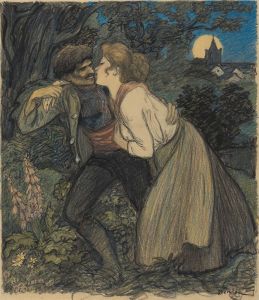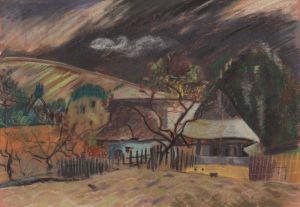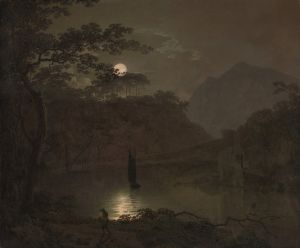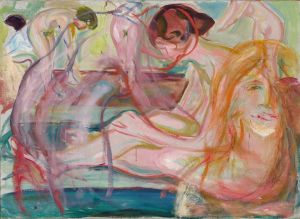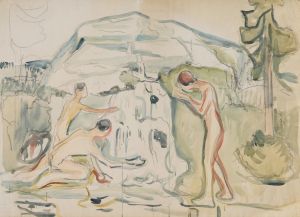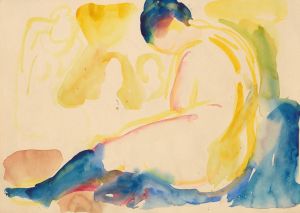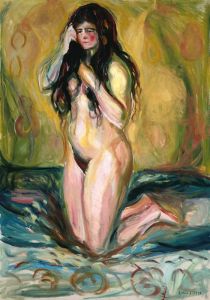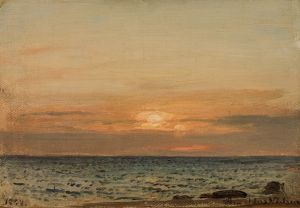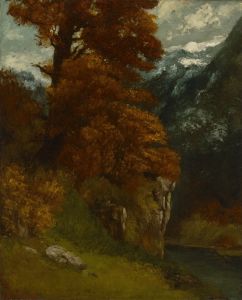
Sommernatt
A hand-painted replica of Edvard Munch’s masterpiece Sommernatt, meticulously crafted by professional artists to capture the true essence of the original. Each piece is created with museum-quality canvas and rare mineral pigments, carefully painted by experienced artists with delicate brushstrokes and rich, layered colors to perfectly recreate the texture of the original artwork. Unlike machine-printed reproductions, this hand-painted version brings the painting to life, infused with the artist’s emotions and skill in every stroke. Whether for personal collection or home decoration, it instantly elevates the artistic atmosphere of any space.
Edvard Munch, a renowned Norwegian painter, is best known for his evocative and emotionally charged works that delve into themes of existentialism, love, and death. One of his lesser-known but equally captivating paintings is "Sommernatt," which translates to "Summer Night." This painting is a testament to Munch's ability to capture the nuanced interplay between nature and human emotion.
"Sommernatt" was created during a period when Munch was deeply influenced by the Symbolist movement, which sought to express ideas and emotions through symbolic imagery and themes. This movement was characterized by an emphasis on the subjective experience and the exploration of the human psyche, elements that are evident in Munch's work.
The painting depicts a serene and contemplative scene set during a summer night, a time when the natural world is often at its most tranquil and introspective. Munch's use of color and light in "Sommernatt" is particularly noteworthy. He employs a palette of soft blues and greens, which evoke a sense of calm and introspection. The gentle illumination of the night sky and the subtle reflections on the water create an atmosphere that is both peaceful and slightly melancholic, a hallmark of Munch's style.
Munch's technique in "Sommernatt" reflects his mastery of capturing mood and emotion through his brushwork and composition. The fluidity of his strokes and the blending of colors suggest a seamless transition between the physical and emotional landscapes. This approach allows viewers to immerse themselves in the scene, experiencing the quietude and introspection that a summer night can inspire.
The painting is also indicative of Munch's fascination with the natural world and its ability to mirror human emotions. In "Sommernatt," the tranquil setting serves as a backdrop for contemplation, inviting viewers to reflect on their own experiences and emotions. This connection between nature and emotion is a recurring theme in Munch's oeuvre, underscoring his belief in the interconnectedness of the external world and the inner self.
"Sommernatt" is part of Munch's broader exploration of themes related to the human condition. Throughout his career, Munch sought to capture the complexities of human emotion and the existential questions that arise from our interactions with the world around us. This painting, with its serene yet introspective quality, exemplifies Munch's ability to convey these themes with subtlety and depth.
While "Sommernatt" may not be as widely recognized as some of Munch's other works, such as "The Scream" or "The Madonna," it remains an important piece within his body of work. It highlights his skill in using the natural environment to evoke emotion and provoke thought, a testament to his enduring influence on the art world.
In summary, Edvard Munch's "Sommernatt" is a poignant example of his ability to blend natural beauty with emotional depth. Through his use of color, light, and composition, Munch creates a scene that is both tranquil and thought-provoking, inviting viewers to explore the intricate relationship between nature and the human experience.





